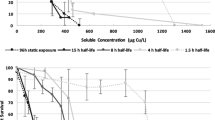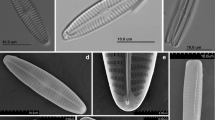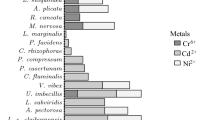Abstract
The extended free ion activity model (FIAM) was developed by integrating concepts from the original FIAM into biological receptor theory, to obtain a conceptual model that more precisely quantifies the interaction of chemical species at biological receptor sites. The extended FIAM was tested by determining the acute (48 h) valve movement behavior (VMB) (measured in terms of the duration of valve opening) of the Australian freshwater bivalve, Hyridella depressa, to increasing concentrations of total Cd or Cu, in a standard synthetic water under conditions of varying pH (6.5–7.5) and/or dissolved organic carbon (as model fulvic acid (FA)) concentrations (0–11.2 mg L−1). Valve movement behavior, measured using an automated data acquisition system, was shown to be a quantifiable and rapid, real-time endpoint for assessing the toxic effects of Cd and Cu exposures. The VMB of H. depressa to Cd was independent (p > 0.05) of pH and/or model FA concentration. In contrast, the VMB of H. depressa to Cu was highly dependent (p < 0.001) on pH and/or model FA concentration; individuals were more sensitive to Cu at low pH and model FA concentrations. The VMB of H. depressa was directly proportional to the activity of the free metal ion (Cd2+), for the linear region of the concentration-response curves. In contrast, the VMB of H. depressa was a weighted function of the activities of the free metal ion and the 1:1 metal hydroxide species (i.e. 2.02 × Cu2+ + CuOH+), whereby Cu2+ had a two-fold greater binding affinity than CuOH+ at the cell membrane surface. Moreover, the results for Cd and Cu are consistent with the extended FIAM, as opposed to the original FIAM, where the result for Cu would be regarded as an exception. The extended FIAM explained 98% of the variability in VMB, whereas the original FIAM explained only 63% (i.e. an improvement of 35%). The improved predictability of organism response to Cu is relevant to advancing water quality guidelines for protecting aquatic biota.
Similar content being viewed by others
Author information
Authors and Affiliations
Rights and permissions
About this article
Cite this article
Markich, ., Brown, ., Jeffree, . et al. The Effects of pH and Dissolved Organic Carbon on the Toxicity of Cadmium and Copper to a Freshwater Bivalve: Further Support for the Extended Free Ion Activity Model. Arch Environ Contam Toxicol 45, 479–491 (2003). https://doi.org/10.1007/s00244-003-2175-x
Issue Date:
DOI: https://doi.org/10.1007/s00244-003-2175-x




